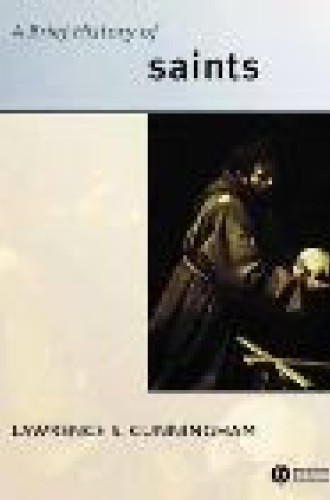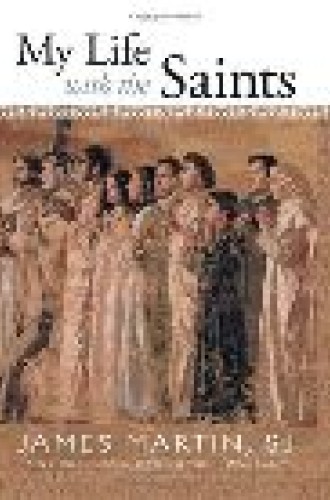A Brief History of Saints/My Life with the Saints/Saints: A Visual Guide
The word saint comes from the apostle Paul. Just as he became the architect of the word love, in his first letter to the Corinthians, he also developed the first Christian understanding of holiness and sainthood throughout his epistles. Notre Dame professor Lawrence Cunningham explains in his succinct but exceptional guide, A Brief History of Saints, that Paul’s frequent use of the Greek word agios as a generic term for members of the early Christian communities was a way of saying that “by their identification with God, through the saving works of Christ, they have become linked to and identified with God and, in this sense, are saints.”
In the early church, the first collectively recognized saints were created by popular demand. They were the martyrs who were deemed to be heroes of the faith; they were considered laudable in heaven and therefore able to intercede for the earthbound in prayer. Making saints was a democratic process in late antiquity, and the people knew a saint when they saw one.
It was centuries later that the bishop of Rome became central to the process of declaring beatification and then canonization. The ultimate test of sanctity became the demonstration that miracles had resulted from prayers offered to a would-be saint. A case had to be made for each candidate’s heroic virtue and so on, giving rise to church courts and attorneys. The Catholic Church today requires so much documentation and adjudication to declare a new saint that many in the church have advocated doing away with the formalities and returning to the ancient model. Other Catholics, such as James Martin, S.J., have simply taken to using the word saint in the broader sense, while still upholding the value of the church’s traditions. In his intriguing memoir My Life with the Saints, Martin offers extended reflections on 16 saints, two of whom are not officially approved and may never be: Dorothy Day and Thomas Merton.
Throughout his book, Martin shows how the saints have accompanied and been companions to him. He organizes the 16 chronologically, in the order in which they influenced his life, hoping that “you might be able to follow the progress of my own spiritual journey as you read about their lives.” The result is an enlightening overview of the familiar (Joan of Arc, Mother Teresa, Francis of Assisi), as well as an education in the relatively unknown (Pedro Arrupe, the Ugandan martyrs, Aloysius Gonzaga). There are many interesting and occasionally unusual bits of new information in Martin’s book—Dorothy Day liked to watch Masterpiece Theatre on television?—and his warm style invites readers to get to know the saints as people.
Martin’s first-person-singular approach to telling the stories of saints will not appeal to everyone. It is not uncommon for the word I to appear three times in a sentence, or eight to ten times in a paragraph. “I was starting to wonder. . . . Then I realized . . .” and so on. But the lessons of this approach are essential for all Christians: our lives intersect at every turn with saints. In coming to know saints personally, we come closer to figuring out what sort of saint each of us is supposed to become.
Christians of most traditions will agree that sainthood is utterly and completely incarnational. Sainthood is the marriage of God and the individual man or woman, of the spirit and the flesh, the heavenly and the earthly, the transcendent and the imminent, in a kind of perfection that is available and possible today. It is ordinary in its simplicity but miraculous and extraordinary too.
In the broadest sense, sainthood happened to each of us before we were born—God made it possible in Christ—and now we must know it and grow into it. There is a unique way in which each of us is to become Christ in the world. If we allow God to be so close as to become flesh in us, then being saints—living our vocation—will come naturally.
There is a tradition in Judaism that says if you are about to plant a tree and you hear that the Messiah has come, you should go ahead and plant your tree before you go out to meet him. The point of the teaching is this: the people of God bring about the kingdom of God. Do what you do to bring about the kingdom. In that is your sainthood.
Edward and Lorna Mornin’s Saints: A Visual Guide is another tour of the familiar—and of the less so—from St. Michael the Archangel to St. Pius of Pietrelcina (d. 1968), better known as Padre Pio. Each brief history is accompanied by a full-color piece of popular art, a classic painting or some other image of the saint. The art selections are the real treasure of this sturdy little paperback; while many are flash photos taken in churches and cathedrals, the quality of reproduction is excellent and the subjects are often unfamiliar. Some of the most profound images of the saints in the churches of Western Europe are in the media of polychrome and plaster, and the Mornins capture many of these (the images of saints Jude, Laurence and Roch, for instance) in ways that cannot be found in other books or matched by the paintings of the masters.
All of the saints in the Mornins’ book are of the traditional, officially canonized variety, and their short biographies are full of reports of miracle working that make the modern mind suspicious. The Mornins seem to repeat these stories for their charm value—rather than as faith examples, as they would be treated in more traditional guides. Such fantastic tales lead many to dismiss saints altogether, as if saints are not genuine articles of faith. I am reminded of the French Protestant Paul Sabatier, who contrasted Anthony of Padua, with his abundant miracles, to Anthony’s mentor, Francis of Assisi, who lived more simply: St. Anthony’s life “was rather the prospectus of some scientist who had invented a new drug than a call to people to conversion and a higher life. It may interest invalids or devotees, but neither the heart nor the conscience is touched by it.”
Sabatier’s point is simply that there is a sort of sainthood that does not dwell in the fantastic but is instead aimed at conversion and spiritual formation. Ironically, although it may be the miracle that defines the saint in the eyes of the official church, the real gold among the straw is the way in which the converted life draws others to conversion as well.
Speaking directly to contemporary Catholic readers, Martin writes:







